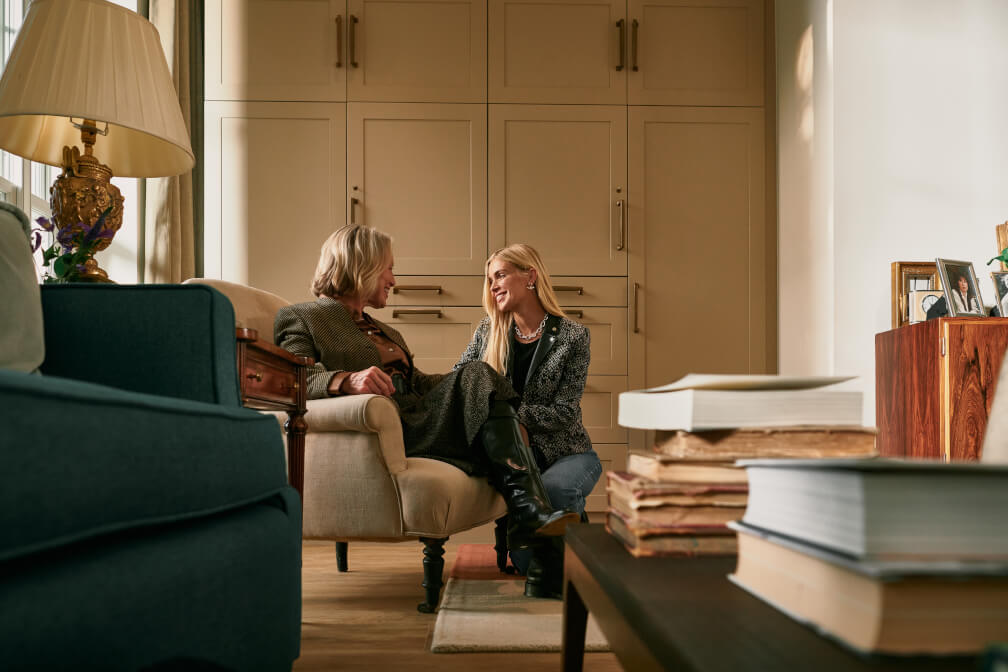Ensuring the safety of an individual living with dementia at home is a responsibility that requires careful planning, attention to detail and an adaptable approach. Dementia affects memory, judgement and spatial awareness, which can increase the risk of accidents, confusion and distress in everyday activities. With the right combination of practical adjustments, environmental changes and technology, families can create a safe and supportive living space that helps their loved ones live with confidence and as much independence as possible.
Practical Measures to Improve Home Safety for Dementia
Adapting the home environment, or “dementia-proofing a house” is often the first and most impactful step to managing safety risks for an individual living with dementia. Consider these essential actions:
- Labelling household items is a straightforward but effective way to support orientation and reduce anxiety. Large, clear labels on cupboards, drawers, appliances and bathroom fixtures help your loved one identify objects and their purpose. Use simple language and even pictures where possible, making the environment easier to navigate.
- Fall prevention- elderly people are at greater risks of falls and they are a leading cause of injury in people living with dementia. To reduce this risk:
- Remove loose rugs or secure them with non-slip pads.
- Ensure hallways and rooms have sufficient lighting, ideally with sensor-activated night lights.
- Install grab rails on stairs and in bathrooms.
- Keep floors clutter-free and clear walkways.
- Encourage wearing well-fitting shoes with non-slip soles indoors.
- Bathroom safety dementia – bathrooms can pose multiple hazards, so consider installing:
- Non-slip mats inside and outside the shower or bath.
- Raised toilet seats to ease sitting and standing.
- Lever-style taps that are easier to operate.
- Motion-sensor lighting to reduce confusion during night-time visits.
- Plan for fire safety dementia care by installing and regularly checking smoke detectors. Keep fire extinguishers easily accessible and create an emergency evacuation plan tailored to the needs of the person living with dementia Practice the plan with all family members or carers to ensure everyone understands their role.
- To prevent accidental exits, install security alarms for seniors on doors and windows. These alert carers immediately if your loved one tries to leave the house unnoticed, providing an additional layer of security and peace of mind.
Assistive and Smart Technology for Dementia Safety
Technology has become an invaluable ally in the pursuit of safety and independence for people living with dementia:
- GPS trackers for dementia can be worn as watches, pendants or belt clips, providing real-time location tracking. These devices are especially useful for monitoring individuals prone to exit seeking which can be hazardous. Families can set geo-fenced zones and receive alerts if the person leaves a designated safe area.
- A wide range of assistive technology dementia devices are designed to simplify daily life. Examples include medication reminders, automated lighting systems and appliances with safety shut-offs to prevent accidents.
- Smart home devices for elderly such as smart locks, thermostats and voice-controlled assistants offer control over the environment remotely. Carers can monitor temperature, lighting and security settings to ensure the home remains comfortable and safe at all times.
- Combining traditional safety measures with technology is an effective way to dementia-proof a house. This approach creates a comprehensive system that adapts to your loved one’s evolving needs and helps maintain their independence while reducing risks.
Additional Considerations for Home Safety – Dementia Tips
Beyond the physical environment and technology, several other factors contribute significantly to the overall safety of people living with dementia at home:
- Regularly reassess the living space. As dementia progresses, risks change and new hazards may emerge. A periodic review ensures the environment remains as safe as possible and adjustments are made in a timely manner.
- Encouraging a structured routine dementia is beneficial for safety as well as wellbeing. Predictable daily patterns reduce confusion and agitation, helping the individual feel more secure in their surroundings.
- Emergency preparedness is vital. Keep emergency contacts, medical information and any care plans clearly accessible to all household members and carers. Consider placing this information near the telephone or on a fridge door for quick reference.
- If space allows, create a safe outdoor area. Access to fresh air and nature supports wellbeing, but it must be secure to prevent leaving unaccompanied Fenced gardens or patios with locked gates provide a controlled environment.
Addressing Specific Risks
Certain areas of the home and specific behaviours require extra attention:
- Kitchens pose particular dangers due to hot surfaces, sharp objects and appliances. Consider installing safety locks on cupboards and ovens and use automatic shut-off devices for kettles or cookers.
- Staircases and hallways should be well lit with handrails firmly installed on both sides. If mobility becomes a concern, consider installing stairlifts or restricting access where possible and safe to do so.
- Bedrooms should have minimal obstacles and soft flooring where possible to reduce injury risk from falls. Bed alarms can alert carers if the person gets up during the night.
Supporting Carers and Family Members
Caring for a person living with dementia at home is rewarding but can be challenging. Ensuring safety is a collective effort that benefits from support and education:
- Understand that the risk of caregiver stress management is high. Seek respite care options and support groups to maintain your own wellbeing.
- Training on safe dementia care techniques can provide practical skills and confidence in managing challenging situations.
- Use de-escalation and calming strategies during episodes of agitation or confusion to prevent accidents and maintain a safe environment.
The safety of a person living with dementia at home requires a multi-faceted approach combining practical modifications, technology, ongoing vigilance and emotional support. Every home and individual is unique, so solutions should be tailored to personal needs and preferences.
At Loveday, we recognise the importance of creating secure and comfortable environments that adjust as needs evolve. Our team is available to provide advice on safety measures, assistive technologies and care plans to help families support their loved ones living with dementia.




